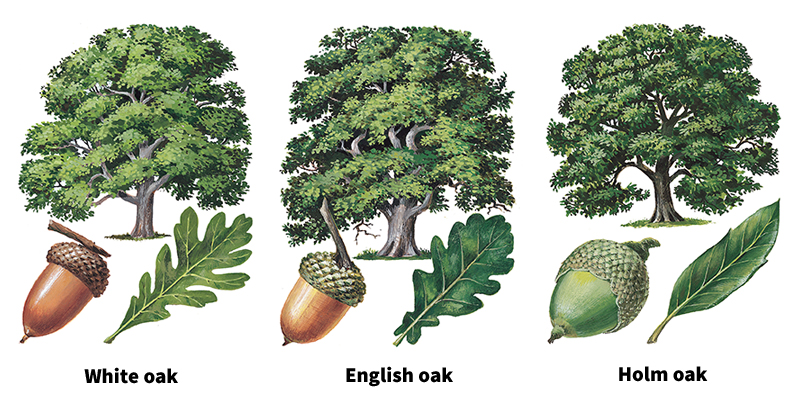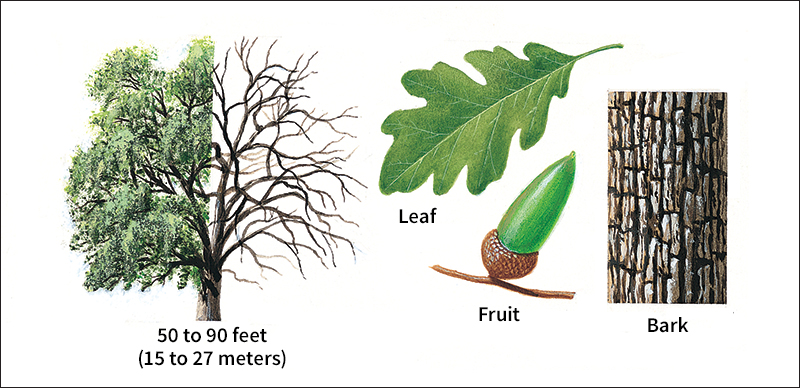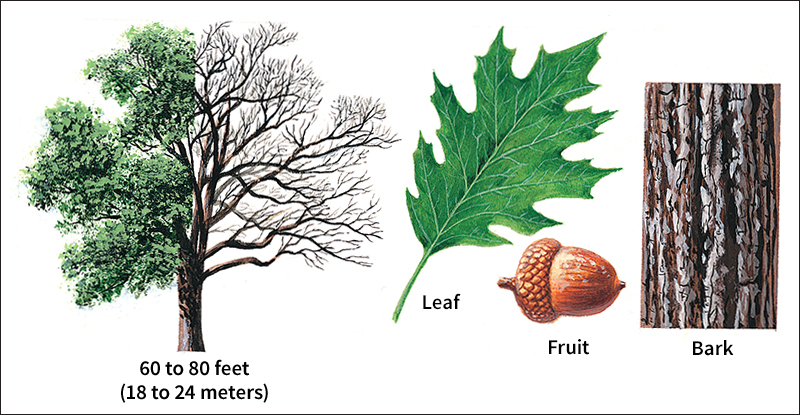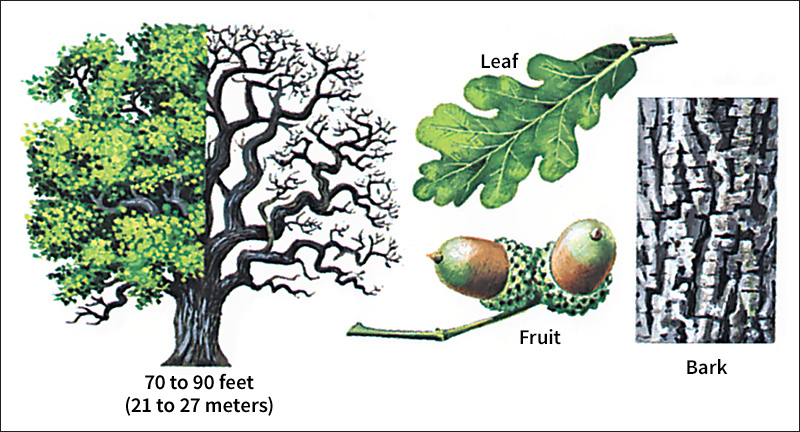Oak is any of a large variety of trees or shrubs that bear acorns. There are several hundred species (kinds) of oaks, all of which grow naturally only in the Northern Hemisphere. Most species of oaks are found in tropical and warm regions. Only a few species grow in Canada and other regions that have short summers and long winters. Oaks thrive in forests throughout the continental United States except for Alaska. They also are important in forests of China, Japan, and central and southern Europe.

Oaks vary widely in size and in the way they grow. Some oaks never become taller than small shrubs. Others reach heights of more than 100 feet (30 meters). Many oaks that grow in warm climates do not lose their leaves in the autumn. They are called evergreens. But most oaks found in regions with cold winters are deciduous—that is, they shed their leaves each autumn. The leaves of many deciduous oaks turn beautiful colors, such as deep red or golden-brown, in early autumn.
In the spring, oaks produce small, yellowish-green flowers. The male flowers, which form in dangling clusters called catkins, produce large amounts of pollen. The wind carries the pollen to the female flowers and fertilizes them. Once fertilized, a female flower will become an acorn. The acorn is the fruit of the oak. Acorns vary in length from less than 1/2 inch (13 millimeters) to more than 2 inches (51 millimeters).
Oaks grow slowly and usually do not bear acorns until they are about 20 years old. But these trees live a long time. Most oaks live for 200 to 400 years.
Oaks are an important source of lumber. Oak wood is heavy, hard, and strong, and it has a beautiful grain. Manufacturers use it for furniture, barrels, and railroad ties. The wood and bark of some oaks contain tannin, a bitter substance used in the preparation of leather. Cork comes from the bark of certain oaks. Acorns are an important source of food for wildlife. In the past, many Native Americans used acorns for food. Today, oaks are grown as ornamental trees worldwide.
North American oaks
Hundreds of species of oaks are native to North America. Only a few dozen of these species grow north of Mexico. Botanists divide oaks into two groups: (1) white oaks and (2) red oaks, sometimes called black oaks. The trees in these two groups differ chiefly in the shape of their leaves and in how long it takes their acorns to mature.
White oaks have lobed leaves, and the tips of the lobes are rounded. Many red oaks also have lobed leaves, but these leaves have pointed tips that end in a hairlike bristle. Some red oaks have unlobed, oval leaves with a sharp tip.
The acorns of white oaks form in the spring, mature during the summer, and are shed in the autumn. The acorns of red oaks need two growing seasons to mature. In general, white oak acorns taste less bitter than do red oak acorns.
White oaks
thrive throughout deciduous forests of eastern North America. A species that is named the white oak is especially common. It is easily recognized by its grayish bark, which forms shinglelike plates about 20 to 30 feet (6 to 9 meters) up the trunk. Its leaves usually have seven or nine lobes. The wood of the white oak makes excellent furniture.
Several other white oaks are important members of eastern deciduous forests. The post oak grows in dry soils. It has gray bark and leaves with five lobes. The overcup oak, the swamp chestnut oak, and the swamp white oak are common in swampy areas. The leaves of these three species usually have more than seven lobes. The bur oak ranges from the eastern part of the Great Plains east to New Brunswick and Nova Scotia. This species produces large acorns.
Only a few species of white oaks grow in western North America. The California white oak is common along streams and in moist valleys of California, where it provides shade for livestock. This oak has leaves with 7, 9, or 11 lobes. It bears long, slender acorns. The Oregon white oak is found in river valleys and warm, dry areas from central California to southwestern British Columbia. The leaves of the Oregon white oak resemble those of the California white oak, but it has much plumper acorns. The Oregon white oak also grows as a low shrub along the Oregon coast and in mountainous regions. This oak may be found as high as 4,000 feet (1,200 meters) above sea level.

Red oaks
are common in forests of eastern North America. The northern red oak grows from the southern Appalachian Mountains north to Ontario and Nova Scotia, and west into Arkansas and Missouri. It is often found along with two other red oak species, the black oak and the scarlet oak. These three species look similar, and even experts sometimes confuse them. All three species usually have leaves with seven or nine lobes. But the leaves of black oaks have yellow hairs on the underside. Most scarlet oak leaves have sharply pointed tips and deep notches between the lobes. These oaks are an important source of timber and tannin.

Many red oaks grow only in certain soils or locations. For example, the blackjack oak grows in soils that contain much clay. This oak has pear-shaped leaves with golden hairs on the underside. The turkey oak is found in sandy soils of the Atlantic coastal plain. Its leaves have deeply notched edges.
Evergreens in the red oak group are often called live oaks. The live oak of the Southern States grows in the Gulf and Atlantic coastal plains. Its large, spreading branches are often draped with Spanish moss. In coastal dune areas, these trees grow as shrubs. Live oaks are also common in dry regions of Texas. The California live oak grows on hillsides along the southern California coast, where little rain falls during the summer.
A number of shrubby, evergreen oaks grow in dry areas of California and the Southwest. The California scrub oak is found in regions that have frequent wildfires. Some scrub oaks reach a height of only 3 to 4 feet (0.9 to 1.2 meters). The roots of this oak have many buds. Following a fire, these buds sprout and grow into new shrubs. The shrub live oak is one of several species of shrubby oaks found in the deserts of the southwestern United States and of Mexico. The shrub live oak is common on mountain slopes.
Other oaks
In the United Kingdom and northern Europe, two common deciduous trees are the English oak and the sessile oak, also called the durmast oak. These two species of oaks are easy to tell apart by the way their acorns grow. The acorns of English oaks grow on long stalks. The acorns of sessile oaks attach directly to twigs. Both of these oaks may grow to a height of more than 110 feet (34 meters). Some have lived more than 800 years. The wood of these oaks is used for beams and shipbuilding.

Several deciduous species of oaks also grow in the mountain forests of southern Europe. These include the Hungarian oak and the Pyrenean oak. Both are used for ornament and shade in gardens worldwide.
Live oaks grow in regions of southern Europe that have mild winters. The holm oak looks much like the live oaks of the southwestern United States. It is an important timber tree and an excellent source of charcoal. The holm oak is grown in parks and along roads throughout the world. The cork oak is found chiefly in Spain and Portugal. Cork comes from the bark of this tree.
Many oak species grow in the forests of central and eastern Asia. The Lebanon oak is common in mountainous regions of the Middle East. The Mongolian oak is an important timber tree in eastern Asia, including Japan. Both of these species can be found in parks and gardens in the United States.
